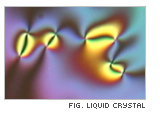Tabe Lab

Static & Dynamic Structures in 2D Liquid Crystals
We are interested in two-dimensional liquid crystals (LCs) such as Langmuir monolayers, free-standing ficlms, bubbles and vesicles, which are the basis of smectic LCs and biomembranes. Because of the lower symmetry and the high fluidity, the 2D LCs often exhibit different features from bulk LCs, for instance, spontaneous pattern formations, emergency of ferroelectricity and unusual non-equilibrium dynamics such as photo-induced traveling waves and coherent molecular precession driven by transmembrane gas transfer. Our aim is to reveal the common and special features of 2D liquid crystals, and propose an idea for new LC applications.
Introduction of Liquid crystals
There are two well-known forms of condensed matter; an isotropic liquid with the highest symmetry has neither positional nor orientational order, while a crystalline solid possessing the lowest symmetry consistent with a regular filling of space has long-range positional and rotational order. Between these two extremes, there are systems with intermediate order and symmetries, among which the most widely studied are liquid crystals. Generally, the liquid crystals are composed of rod-like molecules, the anisotropic structure of which gives rise to the anisotropic intermolecular interaction (mainly repulsion), resulting in the long-range orientational order.
 The most disordered liquid crystalline phase is “nematic”. In this phase, the constituent rod-like molecules can randomly change the position but they align parallel to a particular direction described by a unit vector “n” called “director”. Due to the long-range orientational order and the lack of positional order, nematic LCs are widely used for energy-saving optical devices. Besides the nematics, there are a variety of LC phases with the lower symmetries. In smectic phases, the constituent molecules arrange themselves in well-defined layers, yet in each layer there is no long-range translational order.
The most disordered liquid crystalline phase is “nematic”. In this phase, the constituent rod-like molecules can randomly change the position but they align parallel to a particular direction described by a unit vector “n” called “director”. Due to the long-range orientational order and the lack of positional order, nematic LCs are widely used for energy-saving optical devices. Besides the nematics, there are a variety of LC phases with the lower symmetries. In smectic phases, the constituent molecules arrange themselves in well-defined layers, yet in each layer there is no long-range translational order.
Among various LC phases, we focus on the ones with the simple structures and high symmetry such as nematic (D∞h symmetry), smectic A (D∞) and smectic C (C2h) states. Smectic A and C phases are the most common subclasses of smectics; the molecules are parallel to the layer normal in smectic A state, while they are coherently tilted with a certain angle from the layer normal in smectic C phase. In each smectic layer, there is no positional order and the molecules can move freely like an isotropic fluid. Chiral systems corresponding to these three phases are also interesting and well studied, which should have a strong connection to living things. When chiral dopants with no mirror plane are added to nematics, we have chiral nematics, otherwise known as cholesterics (D∞ symmetry).  In cholesteric phase, the direction of the average molecular alignment rotates along the self-made helix, the pitch of which is typically of order of several hundred nanometers so that the cholesterics scatter the visible light. Smectic A and C phases with additional chiral molecules result in smectic A* (D∞) and smectic C* (local symmetry C2) states, respectively. Similarly to the cholesterics, smectic C* phase has a twist axis normal to the layer and the molecules continuously rotate their tilting direction along the conic helix. The distinctive feature of the smectic C* state is the emergence of ferroelectricity. Because of the lack of mirror symmetry and the layered structure with the tilted molecules, smectic C* phase possesses the spontaneous polarization in the direction perpendicular to both the molecular tilt and the layer normal in each layer. As a result, the electro-optical response in smectic C* phase is much faster than that in nematics, which is used for fast small display panels.
In cholesteric phase, the direction of the average molecular alignment rotates along the self-made helix, the pitch of which is typically of order of several hundred nanometers so that the cholesterics scatter the visible light. Smectic A and C phases with additional chiral molecules result in smectic A* (D∞) and smectic C* (local symmetry C2) states, respectively. Similarly to the cholesterics, smectic C* phase has a twist axis normal to the layer and the molecules continuously rotate their tilting direction along the conic helix. The distinctive feature of the smectic C* state is the emergence of ferroelectricity. Because of the lack of mirror symmetry and the layered structure with the tilted molecules, smectic C* phase possesses the spontaneous polarization in the direction perpendicular to both the molecular tilt and the layer normal in each layer. As a result, the electro-optical response in smectic C* phase is much faster than that in nematics, which is used for fast small display panels.
In our study of 2D LCs, one to several tens of layers of smectic A, A*, C, C* are used. Because of the broken up-down symmetry and the strong surface effects, we can expect new properties in 2D LCs.
